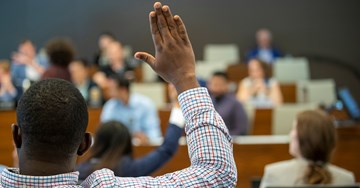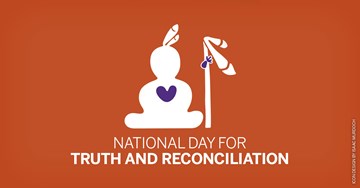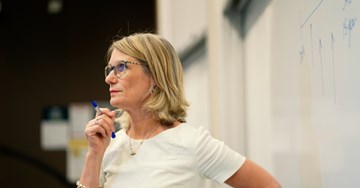On the heels of Canada’s first National Day for Truth and Reconciliation, HBA1 students have begun a journey to increase their understanding of Indigenous cultures, knowledges, and the legacies of settler colonialism in Canada, including the Indian Residential School system.
Through their Learning Through Action course, the 624 students have begun a new on-demand educational program, The Path: Your Journey Through Indigenous Canada™, created by Indigenous consulting company NVision Insight Group. The six-hour program has five modules covering:
- The cultural and historical differences between First Nations, Inuit, and Métis;
- The evolution of the relationship between Canada and Indigenous people;
- Stories of social and economic success, reconciliation, and resilience; and,
- Understanding intercultural communication in the workplace.
The students respond to reflection questions after each module.
The initiative is a collaboration between Ivey and Western’s Office of Indigenous Initiatives, which is licensed to offer the program to Western’s students, staff, and faculty. The HBAs’ participation marks the first time The Path™ has been used in Western’s student programming. Sara Mai Chitty, Curriculum & Pedagogy Advisor, Office of Indigenous Initiatives has been consulting with Ivey on ways to work Indigenous pedagogical approaches and knowledges into the curriculum and recommended The Path™ as a starting point due to its accessible format.
“It’s very basic introduction, online format makes it easy to do on your own time. You can do standalone modules or the full program. It’s something to support faculty who might not be comfortable with the material, or even know it themselves,” she said. “It’s really helpful in getting people to have a basic understanding of Indigenous history in Canada because we know it’s not taught in public school.”
Engaging with Indigenous community members
Chitty is arranging for Indigenous community members to do a debrief circle with the students after the module on residential schools so they can do further reflection and be introduced to the Indigenous pedagogical approach.
“We teach through telling stories. They’ll hear from community members and share their thoughts and unpack a bit of the frustration, embarrassment, and shame that a lot of people feel when they learn about these things for the first time,” said Chitty. “We work with some community members who are really good at doing this with non-Indigenous people to strengthen allyship and understanding of Indigenous perspectives.”
Insights on Truth and Reconciliation
The students will also hear from The Honourable Murray Sinclair, former senator and former chair of the Truth and Reconciliation Commission, who has endorsed The Path™ program. Part of the Ian O. Ihnatowycz Institute for Leadership’s LeaderShift series, Sinclair’s presentation on November 24 has been incorporated into Learning Through Action to complement The Path™ program. And for the students’ reflection assignment partway through the program in December, they will write a paper or present orally. These storytelling, visiting, and self-reflexive approaches to the material and assignments engage Indigenous pedagogical approaches, says Chitty.
Nadine de Gannes, HBA ’09, is Associate Faculty Director of the HBA Program and an Ivey EDI Advisory Council member who has been working on initiatives to address discrimination, sexism, racism, and inequality at Ivey. She said the idea for the Indigenous knowledge content came in summer 2020 after Ivey launched its Equity, Diversity, and Inclusion (EDI) Action Plan. She began working with Erin Huner, Director, Culture and Inclusion at Ivey, on creating space in the HBA1 curriculum for anti-racism content and Indigenous knowledges.
“We started thinking about and asking whose voices were not heard at Ivey and the answer was Indigenous voices. That’s a hard thing for many people to hear, but that was our truth. We hadn’t meaningfully engaged with Truth and Reconciliation as an institution,” she said. “Some faculty members, because of their deep care and concern, had taken steps [to bring these voices] to their courses. But we didn’t have it as an institution – a commitment and the resources to make meaningful change.”
An Impact Assessment Team consisting of eight HBA2 students in the Sustainability Certificate Program will evaluate the HBA1s’ learnings from The Path™, training first with Indigenous leaders on the context of Indigenous learning.
Building on Ivey’s programming
Findings from the HBA1s’ critical reflection assignment will also help to inform Ivey’s future programming as it relates to Truth and Reconciliation. The students are being asked what Truth and Reconciliation means to them and what it should mean to Ivey.
de Gannes said it’s an important addition since students might be unfamiliar with the Truth and Reconciliation Commission’s report or may gain a fresh perspective through The Path™ module.
Expanding Indigenous perspectives across campus
Although Chitty said she hopes Western will eventually have a full open online course focused on local Indigenous histories and knowledges, The Path™ is a good starting point for stimulating curiosity.
“I hope the students’ curiosity is piqued enough that they continue to learn and seek out other resources and do the unlearning and decolonization work themselves. Up until recently I think it has been treated as a very niche aspect of scholarship, but people are now realizing how integral it is to do reconciliation and work with Indigenous Peoples,” she said. “It’s important to learn about history from Indigenous perspectives and be able to apply a decolonial lens, through the reflective skills gained through this process, to their own work.”
Chitty suggests everyone at Western might benefit from taking The Path™ since Indigenous history and perspectives are relevant in every discipline and could see other faculties building it into their programs and onboarding.
“I think this pilot at Ivey is a really good example of doing reconciliation on campus in a collaborative and culturally appropriate and respectful way,” she said. “It’s important to make space for things you might not have set aside time for before so that you can broaden people’s understanding and open their eyes as to how Indigenous history has been portrayed up until this point and how crucial those truths are in continuing reconciliation work.”



